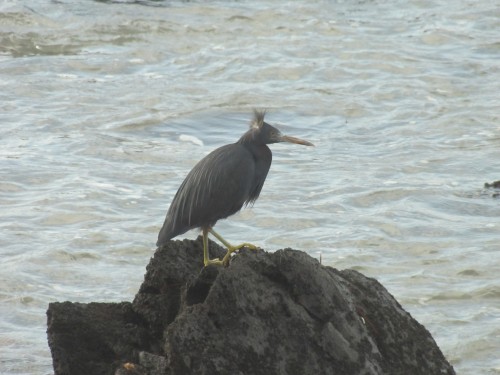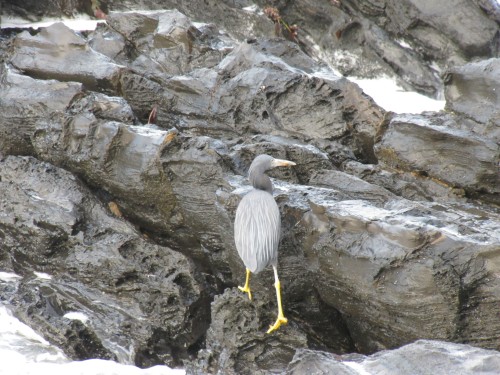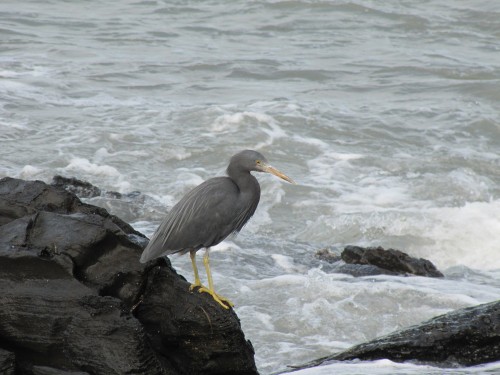Eastern Reef Egret, The Bluff, Victor Harbor
Last month we went on a day trip with friends of ours to Victor Harbor. We primarily went to see the whales but in that quest we were unsuccessful. Best thing we saw was several seals. It was a wild stormy day and I guess the whales used their common sense and stayed under water as much as possible.
During the afternoon we drove to the base of The Bluff, a prominent hill on the south western edge of town. On the short drive to the fishing jetty there are many rocky outcrops close into shore. I’ve always found this spot to be good for birding. I was not disappointed on this occasion either.
This solitary Eastern Reef Egret (also called Eastern Reef Heron) was busy feeding around the rocks, the photo above showing he has a “crest” – it’s actually the blustery wind giving the bird a “bad feather day”.
This species in interesting in that it can be found in both the dark morph, shown in these photos, and a white version. As far as I know this species is not very commonly seen in South Australia, so I have reported this sighting to Birds SA. In fact, I’ve never seen it in South Australia myself. I’ve only seen it twice before – both times in Western Australia many years ago.
This species is not to be confused with the White-faced Heron, shown in the last photo below.
Blue-breasted Bee-eater, Ethiopia
One of my favourite Australian birds would have to be the Rainbow Bee-eater (click here for a photo). They are regular spring and summer visitors to our garden and even occasionally breed on our 5 acre block of land. When I visited Nepal a few years ago I had a brief glimpse of the Blue-bearded Bee-eater and the Green Bee-eater while visiting Chitwan National Park in the southern part of the country.
Before travelling to Africa late last year I knew that several species of bee-eaters could be seen there, so I hoped that I would get good views of at least one species. I was rewarded with not only a good sighting but several photos as well. The Blue-breasted Bee-eater shown in today’s photos is every part as spectacular as the other species I had already seen. The two birds sat obligingly on a branch in full view and in full sunlight until I had some shots. They then continued on hawking for insects.
These birds were seen at the locality known as Portuguese Bridge, about 110km north of Addis Ababa in Ethiopia.
Further reading:
The Rabbit and the Honeyeater
Yesterday I saw one of our resident rabbits hopping through the garden near our rose bushes. It stayed long enough for several good photos. Until earlier this year we only ever saw hares on our property. There were very few rabbits here over the last decade or more – since the accidental release of the rabbit calicivirus in 1995. This year has seen the return of rabbits immune to the virus; not in huge numbers but worrying all the same. We have at least two living on our five acre block.
After taking the photos of the rabbit, a Singing Honeyeater flew in to collect several insects on the window. It paused briefly on the window sill, long enough to get this good photo. It was less than two metres from me.
I love special birding moments like that.
Click on the photos to enlarge the image.
Great Birding Moments # 33: Collared Sparrowhawk
Whenever I hear the alarm calls of the birds in our garden, especially the honeyeaters, I look skywards. I usually expect to see a bird of prey soaring overhead. Sometimes it turns out to be a Black Kite or a Little Eagle. At other times it will be a Brown Falcon sneaking through the lower trees trying to catch an unwary smaller bird.
Several days ago I was watching the Test Cricket (Australia v. India) on television. I heard the usual alarm calls outside and raced out into the garden armed with my camera. I was rewarded with closeup photos of a juvenile Collared Sparrowhawk. This species looks very similar to the juvenile Brown Goshawk – except for the size. Both species occur in our area. This one was definitely a Collared Sparrowhawk because it was about the size of an Australian Magpie.
Collared Sparrowhawks are found throughout most of Australia. Their preferred habitats include forests, woodlands, inland scrubs and farmlands. Their breeding season ranges from August through to December, so this one could well be from last year’s breeding season.
Click on any photo to enlarge the image.
Further reading:
- Early morning walk and a bird of prey – also featuring another photo of this species.
- Great Birding Moments – more highlights from my birding experiences.
Great Birding Moments #32: my first Powerful Owl sighting
2007 Australian Capital Territory trip report #14
During the weeks before departing on our holiday in the eastern states in September, I had read of reports of various birds present in the Canberra region. I had subscribed to the local birding newsgroup, Canberra Birds, on the internet. One of the birds that interested me was a Powerful Owl in the Australian National Botanic Gardens. I also knew that this was one of the places we were definitely planning to visit. As the day approached I had a great deal of excited anticipation. You see, I’d never seen a Powerful Owl ever before. Everyone was saying how easy it was to see this individual roosting in one of the trees near the Visitor Centre of the gardens.
I was determined to find this bird all by myself; a foolish notion in retrospect. The gardens are extensive and there are literally thousands of suitable trees or bushes where this bird might have decided to roost. Finding it was probably right up there with the proverbial needle. Pride does funny things to you. It also prevents you from seeing some really interesting birds.
Near the end of our visit my wife struck up a conversation with one of the volunteers doing some weeding. When I came around the corner with my binoculars at the ready he instantly, in a flash of recognition, realised I was a birder. “Have you seen the Powerful Owl?” he immediately interrogated. When I replied in the negative he gave me some simple instructions as to where to find said bird. It was less than 50 metres from where we stood. I found it easily. Another “lifer.”
I do not think my pride suffered any major dents that afternoon.
When in doubt – ask.
Lesson learned.
Related Articles:
- Great Birding Moments – my archives of other great birding moments.















